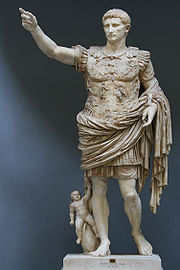
Villa of Livia
Encyclopedia

Suetonius
Gaius Suetonius Tranquillus, commonly known as Suetonius , was a Roman historian belonging to the equestrian order in the early Imperial era....
. The villa's
Roman villa
A Roman villa is a villa that was built or lived in during the Roman republic and the Roman Empire. A villa was originally a Roman country house built for the upper class...
site was rediscovered and explored as early as 1596, but it was not recognized as that of Livia until the nineteenth century . In 1863/4 a marble krater
Krater
A krater was a large vase used to mix wine and water in Ancient Greece.-Form and function:...
carved in refined low relief was discovered at the site and 1867 the heroic marble statue of Augustus, the Augustus of Prima Porta
Augustus of Prima Porta
Augustus of Prima Porta is a 2.04m high marble statue of Augustus Caesar which was discovered on April 20, 1863, in the Villa of Livia at Prima Porta, near Rome. Augustus Caesar's wife, Livia Drusilla, retired to the villa after his death. The sculpture is now displayed in the Braccio Nuovo of...
, which is now in the Vatican Museums
Vatican Museums
The Vatican Museums , in Viale Vaticano in Rome, inside the Vatican City, are among the greatest museums in the world, since they display works from the immense collection built up by the Roman Catholic Church throughout the centuries, including some of the most renowned classical sculptures and...
(Braccio Nuovo). The magisterial Augustus is a marble copy of a bronze statue that celebrated the return in 20 BC of the military standards captured by the Parthians in 53 after the defeat of Crassus at Carrhae: a rich iconography plays out in the low reliefs that decorate his cuirass
Cuirass
A cuirass is a piece of armour, formed of a single or multiple pieces of metal or other rigid material, which covers the front of the torso...
.
The villa occupied the height dominating the view down the Tiber valley to Rome; some of the walling that retained its terraces may still be seen (Piperno). Except for works of terracing—the gardens are currently being excavated—, all that can be seen today are three vaulted subterranean rooms, from the largest of which the fine fresco decor of an illusionistic garden view, where all the plants and trees flower and fruit at once, was removed to Rome; it has recently been reinstalled in the Palazzo Massimo, following cleaning and restoration. The vault above the fresco was covered with stucco reliefs of which only a few survive.
The villa was built and modified in four stages, the earliest of Republican
Roman Republic
The Roman Republic was the period of the ancient Roman civilization where the government operated as a republic. It began with the overthrow of the Roman monarchy, traditionally dated around 508 BC, and its replacement by a government headed by two consuls, elected annually by the citizens and...
date, the latest of the time of Constantine the Great. In the nineteenth century the villa belonged to the convent of Santa Maria in Via Lata; it may never have passed into private hands.
A new series of more meticulous modern excavations was initiated in 1970. Since 1995 exploration at Villa Livia has been undertaken by the Soprintendenza Archeologica di Roma, headed by prof. Gaetano Messineo, in tandem with the Swedish Institute in Rome.
Further reading
- Jane Clark Reeder, 2001. The Villa of Livia Ad Gallinas Albas. A Study in the Augustan Villa and Garden. in series Archaeologica Transatlantica XX. (Providence, RI: Center for Old World Archaeology and Art) (Bryn Mawr Classical Review 20)

